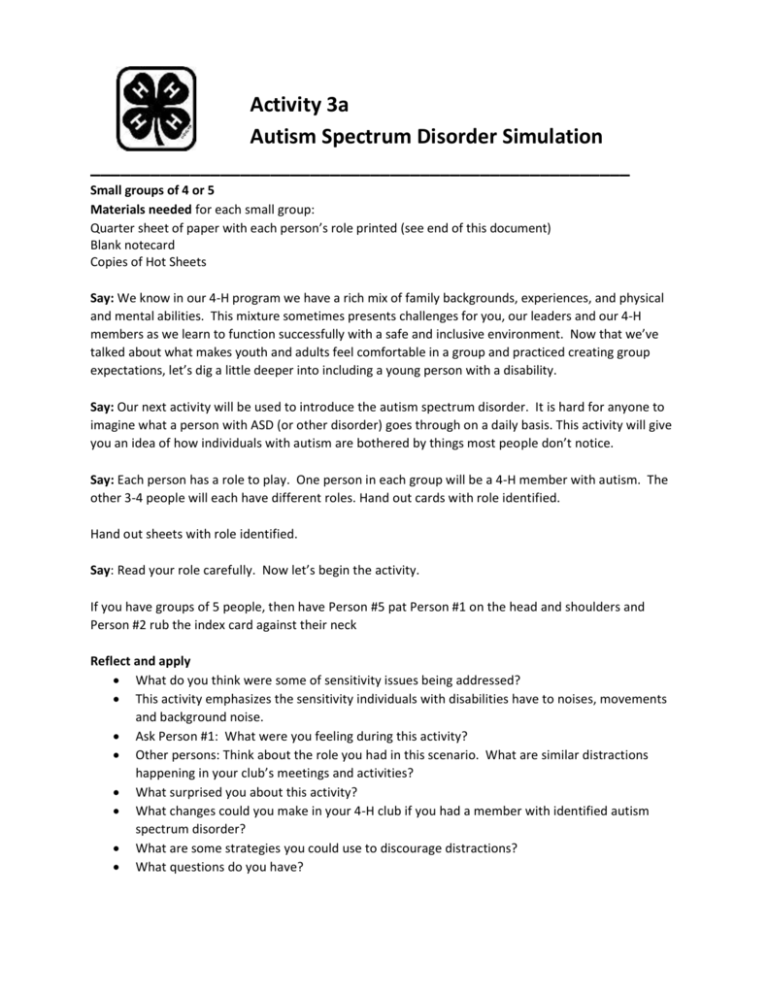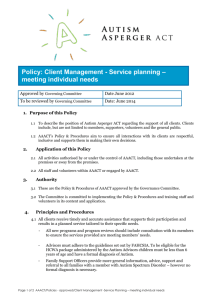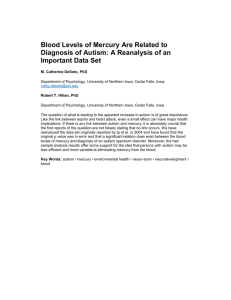Autism Spectrum Disorder activity - Iowa State University Extension
advertisement

Activity 3a Autism Spectrum Disorder Simulation ______________________________________________________ Small groups of 4 or 5 Materials needed for each small group: Quarter sheet of paper with each person’s role printed (see end of this document) Blank notecard Copies of Hot Sheets Say: We know in our 4-H program we have a rich mix of family backgrounds, experiences, and physical and mental abilities. This mixture sometimes presents challenges for you, our leaders and our 4-H members as we learn to function successfully with a safe and inclusive environment. Now that we’ve talked about what makes youth and adults feel comfortable in a group and practiced creating group expectations, let’s dig a little deeper into including a young person with a disability. Say: Our next activity will be used to introduce the autism spectrum disorder. It is hard for anyone to imagine what a person with ASD (or other disorder) goes through on a daily basis. This activity will give you an idea of how individuals with autism are bothered by things most people don’t notice. Say: Each person has a role to play. One person in each group will be a 4-H member with autism. The other 3-4 people will each have different roles. Hand out cards with role identified. Hand out sheets with role identified. Say: Read your role carefully. Now let’s begin the activity. If you have groups of 5 people, then have Person #5 pat Person #1 on the head and shoulders and Person #2 rub the index card against their neck Reflect and apply What do you think were some of sensitivity issues being addressed? This activity emphasizes the sensitivity individuals with disabilities have to noises, movements and background noise. Ask Person #1: What were you feeling during this activity? Other persons: Think about the role you had in this scenario. What are similar distractions happening in your club’s meetings and activities? What surprised you about this activity? What changes could you make in your 4-H club if you had a member with identified autism spectrum disorder? What are some strategies you could use to discourage distractions? What questions do you have? (Note to facilitator: Individual roles are below. Cut paper so each person gets their own role. Do not read these roles aloud to the group.) Person #1: You will play the part of a 4-H member with autism. Your job is to try and listen to what person #4 is reading to you so you can take a test on the material. Try to ignore everyone else. Person #2: Stand behind the person playing the 4-H member with Autism. Rub the edge of an index card against the back of his/her neck. You don’t need to rub hard, but do it over and over. Use your other hand to pat the person on their head and shoulders the entire time. Person #3: Read passage #2, lean close to Person #1 and read in a loud voice the entire time. Passage #2 Typically, educational programs for children with an emotional disturbance need to include attention to providing emotional and behavioral support as well as helping them to master academics, develop social skills, and increase self- awareness, self-control, and self- esteem. A large body of research exists regarding methods of providing students with positive behavioral support (PBS) in the school environment, so that problem behaviors are minimized and positive, appropriate behaviors are fostered. It is also important to know that, within the school setting: •For a child whose behavior impedes learning (including the learning of others), the team developing the child’s Individualized Education Program (IEP) needs to consider, if appropriate, strategies to address that behavior, including positive behavioral interventions, strategies, and supports. •Students eligible for special education services under the category of emotional disturbance may have IEPs that include psychological or counseling services. These are important related services available under IDEA and are to be provided by a qualified social worker, psychologist, guidance counselor, or other qualified personnel. Person #4: Read passage below to person #1, in a normal voice, then ask questions about what you read. Do NOT try to drown out the other voices. Passage #1 Currently there is no known cause of autism. How- ever, autism has been shown to possibly have a genetic connection. This genetic connection may not be related to a specific gene but may be caused by a combination of defective genes. Presence of certain disorders such as phenylketonuria (PKU) and fragile X syndrome also increases the risk of autism. Some evidence shows that vaccines, such as the MMR vaccine that protects against measles, mumps, and rubella, given at certain times in the developmental process may cause autism. However, it is important to remember that several studies have found no link between autism and the MMR vaccine, and having children vaccinated is still essential. Early intervention is important in treating autism. Children who receive early and appropriate intervention can be taught things more easily, such as adapting to changing situations and acquiring a broader vocabulary. Some children will be able to communicate more effectively if they are taught sign language or allowed to use pictures to show what they want or need and what they are feeling. In some cases, medications such as those used to treat Attention-Deficit Hyperactivity Disorder or depression can help control some of the symptoms of autism such as aggressive behavior. Iowa State University Extension programs are available to all without regard to race, color, age, religion, national origin, sexual orientation, gender identity, genetic information, sex, marital status, disability, or status as a U.S. veteran. Inquiries can be directed to the Director of Equal Opportunity and Compliance, 3280 Beardshear Hall, (515) 294-7612. Issued in furtherance of Cooperative Extension work, Acts of May 8 and June 30, 1914, in cooperation with the U.S. Department of Agriculture. Cathann A. Kress, director, Cooperative Extension Service, Iowa State University of Science and Technology, Ames, Iowa. Fall 2014







